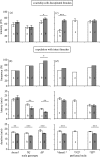A Drosophila male pheromone affects female sexual receptivity
- PMID: 16543174
- PMCID: PMC1560049
- DOI: 10.1098/rspb.2005.3332
A Drosophila male pheromone affects female sexual receptivity
Abstract
Sex pheromones are chemical signals frequently required for mate choice, but their reciprocal role on mate preference has rarely been shown in both sexes. In Drosophila melanogaster flies, the predominant cuticular hydrocarbons (CHs) are sexually dimorphic: only females produce 7,11-dienes, whereas 7-tricosene (7-T) is the principal male CH. Males generally prefer females with 7,11-dienes, but the role of 7-T on female behaviour remains unclear. With perfumed males, control females mated faster and more often with males carrying increased levels of 7-T showing that this CH acts as a chemical stimulant for D. melanogaster females. Control females-but not antenna-less females-could detect small variation of 7-T. Finally, our finding that desat1 mutant female showed altered response towards 7-T provides an additional role for this gene which affects the production and the perception of pheromones involved in mate choice, in both sexes.
Figures


References
-
- Andersson M. Princeton University Press; Princeton, NJ: 1994. Sexual selection.
-
- Antony C, Jallon J.M. The chemical basis for sex recognition in Drosophila melanogaster. J. Insect Physiol. 1982;28:873–880. doi:10.1016/0022-1910(82)90101-9 - DOI
-
- Averhoff W.W, Richardson R.H. Pheromonal control of mating patterns in Drosophila melanogaster. Behav. Genet. 1974;4:207–225. doi:10.1007/BF01074155 - DOI - PubMed
-
- Bennet-Clark H.C. Stimuli provided by courtship of male Drosophila melanogaster. Nature. 1967;215:669–671.
-
- Blows M.W. Evolution of the genetic covariance between male and female components of mate recognition: an experimental test. Proc. R. Soc. B. 1999;266:2169–2174. doi:10.1098/rspb.1999.0904 - DOI - PMC - PubMed
Publication types
MeSH terms
Substances
LinkOut - more resources
Full Text Sources
Molecular Biology Databases
